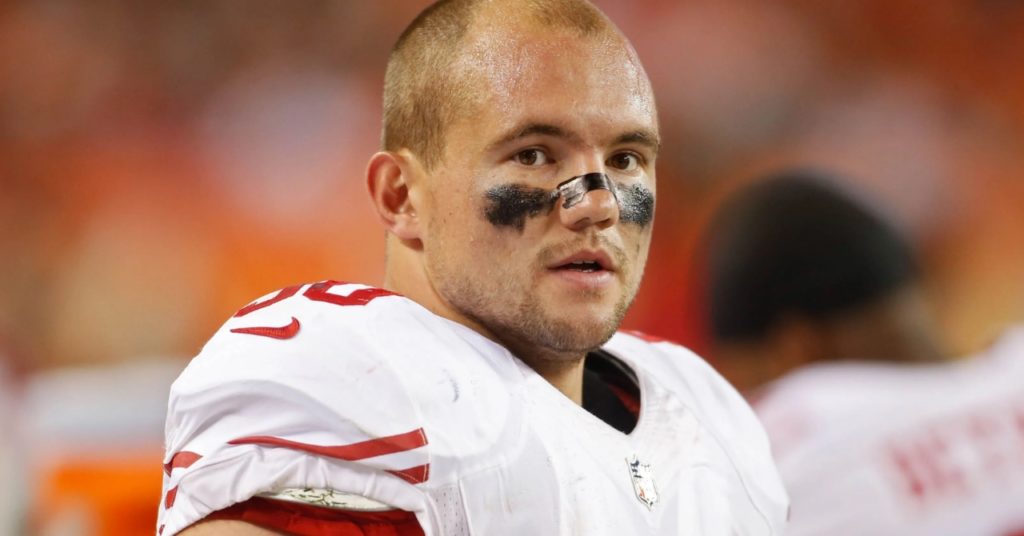News
Former NFL Player speaks to Congress about the NFL and NCAA’s handling of brain injuries

Image Source: Chris Humphreys/USA TODAY Sports
Chris Borland is a former NFL player who retired in 2015 after his rookie season because of concerns about the risk for long-term brain trauma and chronic traumatic encephalopathy. Since then, he has been an outspoken critic of the NFL and NCAA’s handling of brain injuries in football.
This week, he was invited to speak to the U.S. House Committee on Natural Resources’ Subcommittee on Oversight Investigations as one of four witnesses to discuss how large corporations can use disinformation to mislead the public about issues of significant public interest such as public health. Specifically, Borland spoke on the way the major football leagues manipulate not only the public’s perception of brain injuries but also the scientific research into brain injuries and CTE.
Below, we are sharing the statement he prepared and read to the subcommittee, which has been released into public record:
To the members of this committee, thank you for the privilege to testify today to discuss the nature of industry’s manipulation of science and policy as it pertains to brain injury in football.
My name is Chris Borland. I was an All-American linebacker at the University of Wisconsin. In 2014, my first year in the National Football League, I led the San Francisco 49ers in tackles.
I decided to walk away from the game of football after my rookie season in the NFL.
While an active player in the NFL, I spent six months studying the available research on the ramifications of repetitive brain trauma. In relating what I found in the research to my own past experience with brain injury and to the demands of my job, I felt it was in the best interest of my personal health to stop playing football immediately.
Per a 2014 NFL actuary, 28 percent of the league’s players will suffer from cognitive impairment. I had a history of brain injury and played an especially dangerous position as a middle linebacker. Personal experience is important in deciphering such data.
Since leaving football in 2015, I have advocated for players and families that live with the consequences of brain injury.
I’ve gained a keen insight into the failings of industry-funded research. Today, we continue to see industry-funded science misrepresenting the reality of what football players (as well as athletes in other violent games) experience in their sport.
While much of the focus with brain injury research in football has been on the NFL, I would like to highlight how NCAA research into concussion is inherently flawed and why the NCAA fails to portray an accurate risk of brain damage for athletes competing under their organization.
In 2014, the Department of Defense and NCAA collaborated to create what they call “The Grand Alliance,” a $30 million initiative to study concussion. Under the Grand Alliance, a program was launched dubbed the CARE Consortium. CARE is an acronym for concussion assessment, research, and education. In the words of the NCAA and Department of Defense, the Care Consortium “serves as the scientific and operational framework for the Concussion Research Initiative of the Grand Alliance.”
To date, $64 million has been poured into The Care Consortium. There have been 40,000 athletes studied, and the NCAA and Department of Defense report to have captured 3,300 concussions.
Due to disincentivization in reporting concussions that I understand well as a former Big Ten linebacker, I believe the figure of 3,300 concussions flawed to the point of being unusable. My intimate relationship with this research further bolsters my personal experience.
The University of Wisconsin is a member institution in the Care Consortium. I have played with many men that were participants in the study. I know that most of these men appear in the research as having never sustained a concussion. That is, they have never reported sustaining a concussion.
In my experience in football (which is not unique to that of my friends and teammates) symptoms of concussion, whether it be dizziness, tinnitus, imbalance, or others, were weekly occurrences during the season.
The NCAA and Department of Defense routinely fail to acknowledge when sharing Care Consortium data, that an estimated 1/8 to 1/20 concussions is actually reported.
A second glaring omission is that concussion is not believed by neuropathologists to be solely instrumental in brain diseases like Chronic Traumatic Encephalopathy. Focusing only on concussion ignores the repetitive subconcussive hits to the head that football players experience, and that are believed to contribute to neurodegeneration.
To be clear, I feel The Care Consortium does tremendous work researching concussion and developing protocols for those that have been diagnosed.
My concern is that most of us athletes fall through the cracks. The Care Consortium data fails to take into account that the vast majority of concussions go undiagnosed.
The Care Consortium focus on concussion does not capture what may be at the heart of the problem with brain injury in football, repetitive subconcussive hits.
A true scientific and operational framework for concussion would include explicit acknowledgment that players so rarely report the injury.
A genuine inquiry into brain damage from football must include mention of subconcussive hits.
With The Care Consortium, the NCAA and Department of Defense have done a good job studying reported concussions. The Care Consortium has done a better job at distracting athletes and the public by excluding vital information and appropriate context.
I deeply appreciate the opportunity to share my experience in football, with research, and as an advocate for former players. I’ll eagerly and happily answer any and all questions. Thank you!



